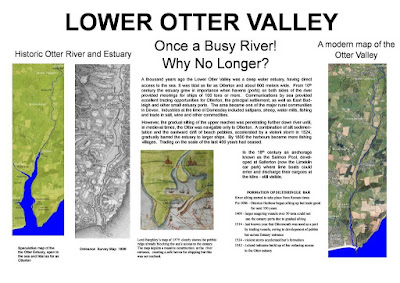Fairlynch values the Valley
Along with the Otter Valley Association and many local councillors
Budleigh Salterton’s Fairlynch Museum rejects the conclusions reached in the
recent Boundary Commission report, and will continue to cover the history and
culture of its traditional area in its exhibitions.
Newton Poppleford war memorial
‘A recent example was our much praised Great War at Fairlynch
exhibition,’ said museum Chairman Trevor Waddington. ‘It focused on the way in
which the 1914-18 world conflict affected the communities along the River
Otter.’
Friends of Fairlynch Mike and Margaret Wilson, from Woodbury, have
been hard at work on designing the above panel which aims to show how the Otter was
once a busy river. They aim to have the panel installed in time for the
Museum’s opening on 25 March.
‘Communications by sea provided excellent trading opportunities
for Otterton, the principal settlement, as well as East Budleigh and other
small estuary ports,’ they point out. ‘However the gradual
silting of the upper reaches was penetrating further down river until, in
medieval times, the Otter was navigable only to Otterton. A combination of silt sedimentation and the eastward drift of beach
pebbles, accelerated by a violent storm in 1524, gradually barred the estuary
to larger ships.’
In spite of these natural changes in the Otter’s course local
historians at the Museum believe that the river continues to be a meaningful
link between its communities.
‘We feel as a museum that the Boundary Commission has ignored the
cultural similarities between the villages of the Lower Otter Valley,’ says
Trevor Waddington. ‘The ward patterns proposed by the
Commission simply do not reflect community interests and identities.’





Comments
Post a Comment